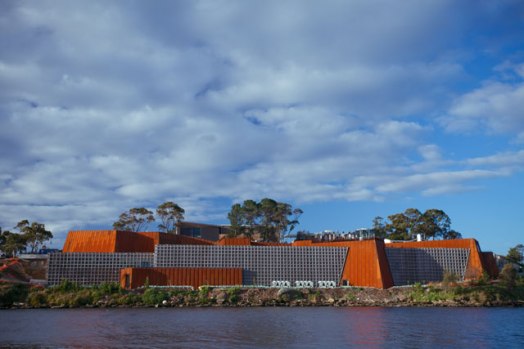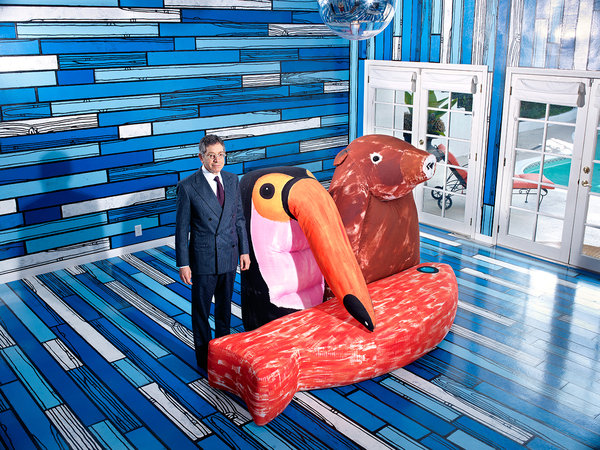Posts Tagged ‘Mexico City’
MOCA Leadership & Their Museums
Jeffrey Deitch will bid adieu to the Museum of Contemporary Art and the Best Coast and head back to New York, where his genius is appreciated and where he is already curating a show. Poor Deitch, un-hip, philistine LA just didn’t get him. The biggest Deitch defender in the press has been Art in the Streets associate curator (non-MOCA curator) Aaron Rose: “We had something going in L.A., and it’s over now. Jeffrey’s resigning is really a statement about what the city is. All people in L.A. want is interior design. They want paintings to put over the couch.” Let’s leave generalizations about “people in L.A.” out of this Aaron Rose, and take a moment to remember that time New York Times Magazine did a spread on “Jeffrey’s Deitch’s Party House.” Let’s talk about that interior design Aaron Rose: Deitch may not have paintings over his couch, but he does have painted couches.
Aztec Pantheon and the Art of Empire
Getty Villa
It’s the first exhibition of neither Greek nor Roman art at the Getty Villa. So why is there an exhibition of Aztec art on display next to rooms full or red-figure amphorae and marble portrait busts?—The Getty curators rationalize that when the Old World met the New World, European explorers rationalized the new civilizations they came in contact with by referencing what they already knew something about: the Greek and Roman civilizations. Or as stated by the Getty: “The premise of The Aztec Pantheon and the Art of Empire is a unique one: that just as classical antiquity colored Spanish perceptions of Mesoamerica, the experience of Aztec civilization piqued curiosity about Renaissance Europe’s own ancient heritage”. I’m not going to discuss whether I was convinced of this after seeing the show, but will discuss the display of this idea.
There are mere weeks remaining to go see Aztec Pantheon and the Art of Empire at the Getty Villa, and if you are not planning on going to Mexico City anytime soon, I would suggest you go. The artworks on display are on loan from the collections of the National Museum of Anthropology and the Templo Mayor Museum. Monumental, multi-ton, stone sculptures and delicate votive figurines have traveled from Mexico to Los Angeles as a way to celebrate the bicentennial of the Mexican Revolution.
Another star attraction is the Florentine Codex, which has traveled even farther, from the Medici Library in Florence, Italy. This is the first time the codex has been in the Americas since it was brought to Europe centuries ago. These loans are displayed alongside objects from the Getty’s collection (mostly small figurines) as well as documents from the special collection of the Getty Research Institute.
The temporary exhibition space at the Getty Villa is an awkward space. The row of adjacent, small-sized galleries combined with the large scale works on loan from Mexico could have been disastrous, but the exhibition designers and curators did a successful job stuffing the herd of Mexican elephants into these small rooms. (Click here to see what it took to display these elephants.)
The exhibition space is also odd because of the hallway that links the rooms; it is architecturally unavoidable because it circumvents the inner peristyle garden of the Villa. The wall title of the exhibition and several large-scale works were placed in this window-lined hallway and lure visitors into the rest of the exhibition.
The rooms were organized thematically: Tenochtitlan, First Encounters, The Florentine Codex, Parallel Pantheons, and Art and Empire. This was predictable technique, but the content of the rooms was not. Seeing Aztec objects displayed next to European objects, like a painted screen depicting the Spanish conquest, was a totally new and unprecedented exploration of history and art.
Located in the center of the room, the looming terracotta Tzitzimitl (Demon) sculpture dominated the first space. The surrounding walls had a variety of objects, maps, scrolls, and other documents. This was simultaneously a display of masterpieces of Aztec art and also a subtle (and possibly unappreciated) display of the impressive collections of the Getty Research Institute.
At the end of the exhibition was my favorite room. On one wall was a painted reproduction of sketch of the Templo Mayor. It was a light element of the exhibition design that was sophisticated and smart. In this room was another looming figure: the unavoidably menacing sculpture of a warrior in an eagle costume. This theme of the Imperial Eagle (Imperial for both the Roman and Aztec civilizations) was continued by two other objects in the room. A massive stone eagle from the Templo Mayor was placed literally face to face with a Bronze statue of an imperial Roman eagle. This confrontation of cultures was direct and beautiful.
As stated before, you should go see this exhibition because the works on loan are rarely seen outside of Mexico. But you should also go see the exhibition because never again will you see these objects like this; in dialogue with objects from the Getty. And finally you should go see this exhibition because contained in it is a brief peek into the extensive collection of the Getty Research Institute, which is a hushed but vital portion of this show.
– H.I.









